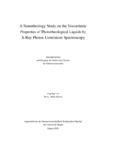Citation link:
http://dx.doi.org/10.25819/ubsi/3437Files in This Item:
| File | Description | Size | Format | |
|---|---|---|---|---|
| Dissertation_Mario_Reiser.pdf | 39.96 MB | Adobe PDF |  View/Open |
| Dokument Type: | Doctoral Thesis | metadata.dc.title: | A nanorheology study on the viscoelastic properties of photorheological liquids by x-ray photon correlation spectroscopy | Other Titles: | Eine Nanorheologiestudie der viskoelastischen Eigenschaften von photorheologischen Flüssigkeiten mithilfe von Röntgenphoton-Korrelationsspektroskopie | Authors: | Reiser, Mario | Institute: | Department Physik Fakultät IV - Naturwissenschaftlich-Technische Fakultät |
Free keywords: | XPCS, Nanorheology, Photorheological Liquids, Network Dynamics, X-Ray Scattering | Dewey Decimal Classification: | 530 Physik | GHBS-Clases: | UCL UKC UKH UJTD |
Issue Date: | 2020 | Publish Date: | 2020 | Abstract: | Networks formed by long cylindrical or wormlike molecules appear in various shapes in nature and technology. They occur on a variety of length scales from nanometers to centimeters and determine especially the mechanical properties of a material, e.g., they control stabilization and transport, and induce interesting phenomena like viscoelasticity. By our nanorheology study on the viscoelastic properties of photorheological liquids, we gained new insight into the complex processes in microscopic networks on the nanometer length scale, in particular, the dynamics mediating the stress relaxation and determining the high-frequency rheology of the system. Photorheological fluids contain entangled networks of wormlike molecules, where the molecular structure and thereby network morphology can be altered by irradiation with light. Aqueous solutions of highly concentrated cetyl trimethylammonium bromide (CTAB) and ortho-methoxycinnamic acid (OMCA) exhibit enhanced viscoelasticity due to the self-assembly of long cylindrical (wormlike) micelles. The photoresponsivity of OMCA gives rise to the characteristic photorheological properties of those fluids that can be tailored by UV illumination. Employing passive nanorheology, the network structure and the associated stress relax- ation processes are accessible through the correlation functions of silica tracer particles measured by microsecond X-ray photon correlation spectroscopy (XPCS). The methods we developed to overcome limitations like beam damage and to analyze big datasets in the low intensity limit will be valuable for future XPCS studies on radiation sensitive systems and microsecond dynamics. We found that the nanorheology results deviate from macroscopic measurements when the confinement of the tracer particles is reduced below a certain threshold indicative of the complex network microstructure. We could further show that the functional form of the stress relaxation is reflected in the shape of the XPCS correlation functions. Anomalous diffusion, especially subdiffu- sive behavior, originates from the coupling between micelle and tracer dynamics. More precisely, we found a transition from exponential stress relaxation due to random scission of micelles to strongly non-exponential, reptation driven stress relaxation of the network, that can be tuned by UV illumination. From the short-time caging motion of the tracers, information on the local viscoelas- tic properties could be reduced on the nanometer length scale and microsecond time scales beyond the limits of classical rheology. Our results indicate high-frequency strain- stiffening of the OMCA-CTAB network due to short-range rigidity of the micelles. Netzwerke aus langen, zylindrischen oder wurmartigen Molekülen kommen in der Natur und Technik in unterschiedlichsten Formen vor. Auf Längenskalen von einigen wenigen Nanometern bis Zentimetern bestimmen sie insbesondere die mechanischen Eigenschaf- ten eines Materials. So können sie z.B. einen Stoff stabilisieren oder den Informations- transport steuern. Zusätzlich führen verschlungene Netzwerke in komplexen Fluiden zu interessanten Phänomenen wie Viskoelastizität. In der vorliegenden Arbeit untersuchen wir die viskoelastischen Eigenschaften von photorheologischen Flüssigkeiten. Wir gewan- nen neue Erkenntnisse über die komplexen Prozesse in mikroskopischen Netzwerken und die Dynamik von Relaxationsprozessen im Bereich von Mikrosekunden. Photorheologische Flüssigkeiten enthalten verschlungene Netzwerke aus wurmartigen Molekülen, wobei die Netzwerkmorphologie durch Bestrahlung mit Licht verändert wer- den kann. Wässrige Lösungen von Cetyltrimethylammoniumbromid (CTAB) und Ortho- Methoxyzimtsäure (OMCA) zeigen verstärkt viskoelastische Eigenschaften aufgrund der Formation von wurmartigen Mizellen. Durch UV-Bestrahlung kann die Mizellenlänge und damit die mikroskopische Struktur des Netzwerks verändert werden. Nanorheologie erlaubt die Netzwerkstruktur und die damit verbundenen Relaxations- prozesse zu untersuchen. Dafür werden der Lösung sphärische Nanoteilchen hinzuge- fügt, sogenannte „Tracer“. Ihre Dynamik kann mit Röntgenphoton Korrelationsspektro- skopie (XPCS) gemessen werden. Die von uns entwickelten Methoden zur Berechnung von Korrelationsfunktionen erlauben Mikrosekundendynamik von strahlensensitiven Sys- temen basierend auf großen XPCS Datensätzen zu analysieren. Unsere Ergebnisse zeigen, dass die Nanorheologie nur in einem gewissen Bereich mit den makroskopischen Rheologiemessungen übereinstimmt. Ab einer bestimmten hydro- dynamischen Korrelationslänge (oder Maschengröße) zeigen die Tracer verstärkt subdif- fusive Dynamik und eine erhöhte Mobilität. Dies ist durch eine schwache Lokalisierung der Nanoteilchen zu erklären, die anfangen sich durch die Maschen des Netzwerks hin- durchzubewegen. Wir konnten weiter zeigen, dass die Form der Spannungsrelaxationsfunktion aus dem Verhalten der XPCS Korrelationsfunktionen abgeleitet werden kann. Anomale Diffusi- on, insbesondere subdiffusive Dynamik, resultiert aus der Interaktion zwischen Mizellen und Tracer Dynamik. Genauer gesagt fanden wir einen Übergang von exponentiellem zu stark nicht-exponentiellem Verhalten. Dies ist auf die „Reptation“-Bewegung der Mizellen zurückzuführen, die durch UV-Bestrahlung zum dominanten Beitrag der Spannungsrela- xation wird. Aus der lokalisierten Bewegung der Tracer, auf Zeitskalen von Mikrosekunden, konnten wir Informationen über die lokalen viskoelastischen Eigenschaften des Netzwerks ablei- ten. Unsere Ergebnisse weisen auf eine erhöhte Steifigkeit des OMCA-CTAB-Netzwerks auf der Nanometer Längenskala hin, die mit der mikroskopischen Mizellenstruktur in Zusammenhang steht. |
DOI: | http://dx.doi.org/10.25819/ubsi/3437 | URN: | urn:nbn:de:hbz:467-16648 | URI: | https://dspace.ub.uni-siegen.de/handle/ubsi/1664 | License: | http://creativecommons.org/licenses/by-nc-nd/4.0/ |
| Appears in Collections: | Hochschulschriften |
This item is protected by original copyright |
Page view(s)
779
checked on Nov 25, 2024
Download(s)
236
checked on Nov 25, 2024
Google ScholarTM
Check
Altmetric
This item is licensed under a Creative Commons License


